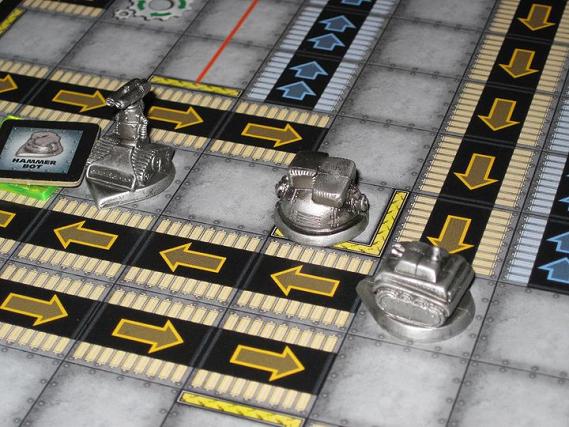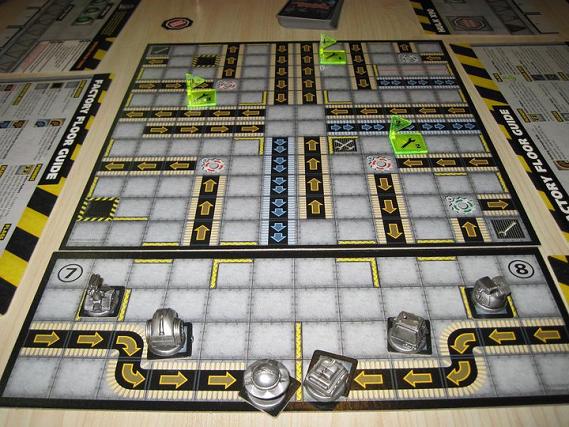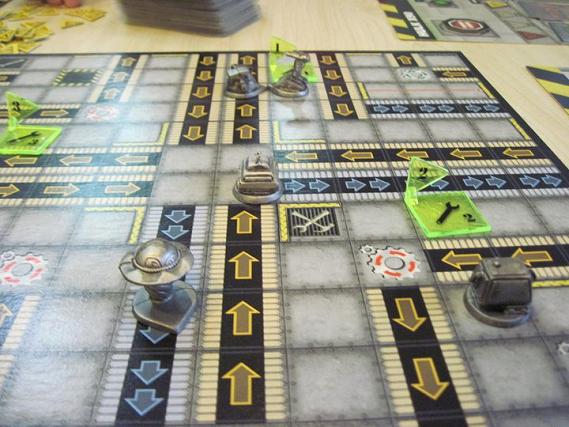
I first heard about RoboRally back when I was still playing Magic: The Gathering. The story was that Richard Garfield was shopping the boardgame around various gaming conventions and brought along the card game as a filler. To his amazement however, it was the card game that became a hit. The success of MTG is by now the stuff of legend but judging by the number of expansions Wizards of the Coast released for RoboRally over the years, this game has its share of fans as well. Even if only to satisfy the spark of curiosity that was first kindled over a dozen years ago, I felt that I should play this game at least once.
RoboRally is a racing game in which each player controls a robot and must guide it through a warehouse to reach a series of flags. This is done by issuing orders to the robots using program cards. There are cards for moving forward between one and three spaces, for rotating in a particular direction, for making a complete U-turn and for backing up one space. During each turn, each player is dealt a total of nine cards and must then select five of these cards to be executed in order by placing them face down on his control mat. Once all players have done this, they uncover the cards one by one and carry out the actions simultaneously. When two robots are close enough to bump into one another, you need to compare the numbers on each program card. The card with the higher number takes effect first, followed by the other card.
This way, if a robot is ordered to move forwards while another robot is in front of it, it will bump the other robot forward along with it, quite likely throwing askew the other player’s programming plans. To complicate things further, the warehouse is a dastardly maze filled with all sorts of contraptions. Walls block movement while conveyor belts carry robots in a fixed direction. Bottomless pits instantly destroy any robots dumb enough to fall into them and some areas even have lasers that inflict damage on robots who cross into the beams. Robots who wander off the board, either through poor programming or more likely being carried off by conveyor belts are instantly destroyed as well.

Last, but not least, all of the robots are equipped with lasers of their own, allowing them to blast any robot directly in front of them. Damage is implemented by reducing the number of program cards the player draws each turn, thereby making it harder to get a decent variety of useful orders. Once you take too much damage however, your order slots become locked so any card that was played there stays there and gets executed every turn which as you can imagine is extremely annoying. A robot that takes ten damage is destroyed. Each players has three lives before they’re out of the game.
Damage can be completely healed by shutting down your robot for a full turn. This is a bit dangerous however as you need to announce it a full turn beforehand and your robot might end up in a bad position when it is actually shut down, such as on a conveyor belt heading towards the edge of the board. Another way to heal damage is to end the turn on a space with a wrench icon on it. This also allows the player to draw an option card which is supposed to give a bonus to the robot, but it didn’t have any real effect in our game.
We were fortunate as we were able to get six players for our session as it’s quite obvious that this is one of those “the more the merrier” games. Or should I say, “the more the more mayhem you get” as all of the robots bump into and shoot at each other.With too few players and the board fixed at the same size, the robots would have too few opportunities to cross each other’s path and hence there would be very little interaction. In our game, I won by a huge margin because after I’d established a decent lead, my robot was far away enough from the rest that I could decide on my program cards without having to worry about other robots knocking me off course. The other players of course kept getting tangled together at the back, making it doubly hard for anyone to catch up with me.

Overall, I had a great deal of fun with this as I quite enjoyed the idea of using cards to program my robot to do various things. I do admit that it’s a bit odd for me to be okay with the mechanic of laying down orders at the beginning of the turn and then resolving them later in this game as I’ve complained about the same thing in Dungeon Lords and Shogun. My only defense is that its quite easy to decide what program cards to use in RoboRally unless someone else messes up your plans but if they do, there’s not much you can do except go with the flow. In the other two games, you are supposed to try and guess what commands the other players are going to issue and figuring out what to do in response becomes a real brain burner.
Like the other racing games I’ve played, RoboRally is pretty lightweight but it does have its good points. I think it would be interesting to see how more experienced players would choose their routes. Would you go for the shorter, more direct route or take a detour in the hopes of avoiding contact with other robots? I’d bet the more advanced maps would make selecting program cards less straightforward as well, forcing players to make harder choices between risk and speed. As a game with the potential to elicit plenty of whoops and groans in equal measure without being too complicated, it’d also make for a good prospect the next time my nieces are in town as my wife has suggested.
Leave a Reply